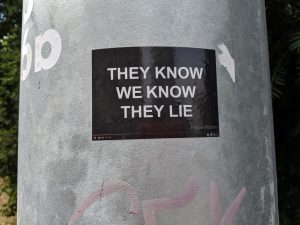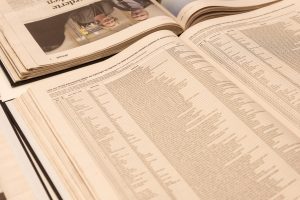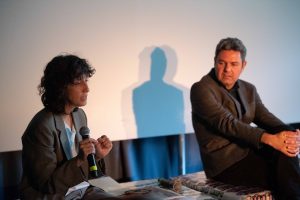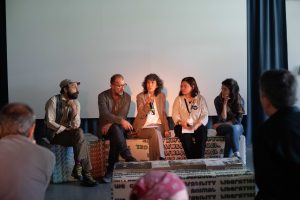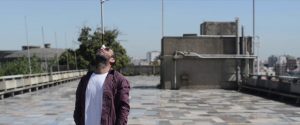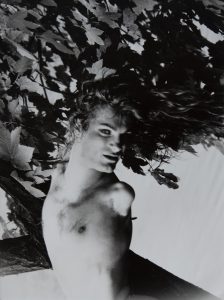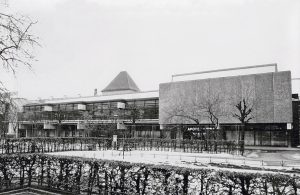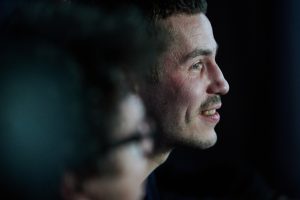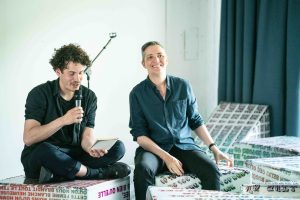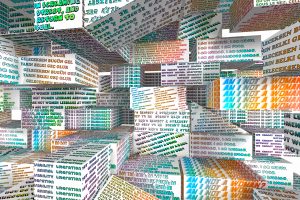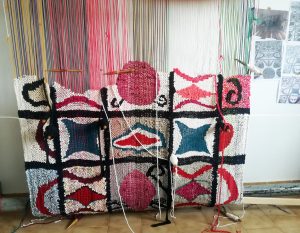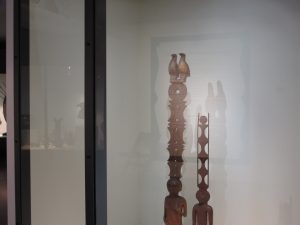Murat Deha Boduroğlu is an independent lawyer dealing with criminal law, human rights, intellectual property rights, administrative law, labour law and environmental law. He is part of the defence team of several ongoing criminal cases in Turkey where artists, cultural actors and others who question political developments in Turkey are imprisoned, as well as one of the volunteer lawyers of the One Hope Association Support Group.
CONTRIBUTION
Workers’ Families Seeking Justice (WFSJ) and its Support Group
Murder Not Accident, 2019
Video, 34′
Camera by Fatih Pınar, edited by Burcu Kolbay and Fatih Pınar
Co-produced by Bergen Assembly 2019
Murder Not Accident documents the collective struggle against ‘work-related serial murders’ in Turkey. In 2018, at least 1,872 people died due to preventable causes while working. The annual death toll of occupational diseases is estimated to be at least six times this figure. None of these deaths are registered as work-related and most of the victims of work- related violence remain unnamed. This is a state of emergency – corporate crime and social murder, which remain deliberately ignored by the government and state entities. In 2008, a group of families mourning loved ones, victims of work- related murders,
came together. They translated their shared grief into a demand for justice. They named their network Workers’ Families Seeking Justice (WFSJ) and gave the victims a name in this struggle:
“We are the families of workers who lost their lives in preventable work-related accidents and occupational diseases, the root reasons of which are duplicated in each new death. That is why we call them ‘work-related murders’. Those who are responsible for them – highest-ranking executives and officials of corporations and public bodies – were never exposed to a just judicial process and continue to enjoy full impunity. We are mourning together and our claim for justice is to ‘remember the dead and fight for the living’.’
The Support Group, a solidarity network of urban planners, architects, lawyers and other activists from Bir Umut Derneği (One Hope Association), based in Istanbul, share a common cause with the Workers’ Families. Since May 2012, on the first Sunday of each month, the Families and the Support Group have held a Vigil for Conscience and Justice on Galatasaray Square in the centre of Istanbul. The vigils were held there 74 times and were banned on the 75th occasion. The reasons given for the ban were the precise
ones for which the families have fought for so long: ‘national security, public order, the protection of public health’.
Yet Workers’ Families Seeking Justice hold on to their demand. Concurrently, since 2012, the Support Group has published seven almanacs about the murders, tracing the national press coverage and some local, non-published sources as well as highlighting the families’ demands for memory and justice.
RELATED PLATFORMS
Bergen Assembly 2019 core group member Banu Cennetoğlu’s artistic practice explores the political, social, and cultural dimensions of the production, representation, and distribution of knowledge, how this forms a society’s collective thinking and is addressed in a society’s ideology.
07.06.2019, 2019
National, regional and local newspapers published in Norway on 7 June 2019, bound
Co-produced by Bergen Assembly 2019
The work 07.06.2019 compiles national, regional, and local newspapers published in Norway on 7 June 2019. Indexed and bound as a reference library and a ‘unique object’, the ongoing project, which has previously been undertaken in Turkey (28.08.2010/14.05.2019), Switzerland (14.01.2011), 20 Arabic-speaking countries (02.11.2011), Cyprus (29.06.2012), United Kingdom (04.09.2014), and Germany (11.08.2015), deals with the politics and hierarchy of news dissemination while generating a portrait of different geographies at this particular point in time.
In conjunction with 07.06.2019 Cennetoğlu facilitated the distribution of The List in the Norwegian daily metropolitan newspaper Bergensavisen.
Compiled and updated each year by UNITED for Intercultural Action, an anti-discrimination network, The List traces information relating to the deaths of 36,570 people who have lost their lives within or on the borders of Europe since 1993 due to state policies (documented as of 1 April 2019). Since 2007, in collaboration with art workers and institutions, Cennetoğlu has facilitated updated versions of The List using public spaces such as billboards, transport networks, and newspapers.
The List has been updated for local cases and translated into Norwegian by a group of five scholars and activists: Kari Hagatun, Mari Norbakk, Ørjan Skaga, Cathrine Talleraas and Sunniva Vik and copyedited by Ama Hanssen. This collective process aims for a discursive, transformative translation process through which there could emerge a place and time to problematise and reflect on the politics of mourning and listing.
In collaboration with Bergen Assembly 2019, Bergensavisen disseminated The List in print and online on 7 June 2019. Copies of the newspaper with a 48-page supplement are available at Belgin from 8 June 2019.
www.list-e.info
unitedagainstrefugeedeaths.eu
SC Conversations: Alexandra Délano Alonso, Thomas Keenan, Sohrab Mohebbi, and Benjamin Nienass
Banu Cennetoğlu lives and works in Istanbul. Recent solo shows include Sculpture Center, New York (2019), Chisenhale Gallery, London (2018), Bonner Kunstverein (2015) and Kunsthalle Basel (2011). Her work was presented at, among others, 10th Liverpool Biennial (2018), Stories of Almost Everyone at Hammer Museum, Los Angeles (2018), documenta 14 in Athens and Kassel (2017), The Restless Earth at Fondazione Nicola Trussardi, Milan (2017), 10th Gwangju Biennale (2014), Manifesta 8 in Murcia (2010) and the Turkish Pavilion at the 53rd Venice Biennale (2009). In 2016, she was a guest at the DAAD Artists-in-Berlin Program.
RELATED PLATFORM
María García, member of the Bergen Assembly 2019 core group, is a visual artist and independent researcher investigating the production and representation of territory through the articulation of hybrid narratives between image, writing and action.
She curated Machines for living: Flamenco and architecture in the occupation and eviction of spaces in Palau de la Virreina in Barcelona (together with Pedro G. Romero and Valentín Roma, 2018). From 2015–16 she was Research Fellow in Residence at the Museo Nacional Centro de Arte Reina Sofía in Madrid. Her artistic work was presented at the Vienna Secession (2014), MUSAC in Leon (2018), and Fabra i Coats in Barcelona (2018), among others.
María García lives and works in Barcelona.
CONTRIBUTION
political parties
Curatorial Contribution by Pedro G. Romero and María García
When Bergen Assembly invited us to rethink the idea of what an assembly can be, our research focused on Asamblea general (General Assembly), an early 19th-century text by Serafín Estébanez Calderón (known as ‘El Solitario’), which was an intimation of what flamenco would become. The text is an account of a feast, a description of a festive celebration of what was actually a kris: a Roma assembly, court or forum of the Andalusian Roma of Cádiz, Málaga and Seville, who gathered in Triana to resolve disputes, demarcate areas of influence, establish family ties, get to know each other and reinforce self-government.
From there, from the shift implicit in Asamblea general, we embarked on an archaeology of that joint understanding of party and political assembly. Asamblea general itself refers to the genealogy derived from Goya, who was also a key influence of Francisco Lameyer, the illustrator of the text. From that point, exploring fields such as bohemia (Rosario Weiss, SEM/EN, Carlos González Ragel), the avant-garde (Helios Gómez, the Cologne Progressives’ Lumpenbälle, Federico García-Lorca) and the counterculture (Toto Estirado, Ocaña, Mario Maya), right up to the immediate present (PEROU, Flo6x8, Israel Galván), we have brought together some instances that express this conjoining of parties and politics in a single gesture. It should be understood that we are not talking about a dialectical pair, but rather a ‘gay politics’, in the sense of Nietzsche’s gay science, which in its pathos makes no distinction between festive forms and the forms of politics. As Allan Sekula said in reference to Darcy Lange’s work: ‘it was not about a party to celebrate a political decision, but about the fact that the party is the community’s only possible political space, where it finds and recognises itself’.
RELATED PLATFORMS
Exhibition
The Parliament of Bodies
b. 1975, Sulaymaniyah, Iraqi Kurdistan; lives in Berlin, Germany
Bergen Assembly 2019 core group member Hiwa K’s sculptures, videos and performances draw on personal memories to explore the tension between the individual and the collective and to tell stories of ongoing global crises: war, migration and the effects of neoliberalism and colonialism. His work often involves participatory dimensions and collaborations with a wide cast of players.
Recent solo exhibitions include S.M.A.K. Museum of Contemporary Art, Ghent and Kunstverein Hannover (both 2018), KW Institute for Contemporary Art, Berlin (2017), De Appel, Amsterdam (2017), Konsthall C, Stockholm (2015) and Serpentine Gallery, London (2010). Hiwa K’s works have been included in major group exhibitions at documenta 14 in Athens and Kassel (2017), the 56th Venice Biennale (2015), New Museum, New York (2013) and Manifesta 7 in Bolzano (2008), among others. In 2016, he received the Schering Stiftung Art Award, as well as the city of Kassel’s Arnold-Bode-Preis.
CONTRIBUTIONS
“When I was eight years old we lived near a military base with very high walls. They were probably about ten metres high or so, but as I was a child they seemed higher. Our house was built not very far away – a few metres – from these walls and, in 1980, when this happened, the Iran-Iraq War had just started (1980–88). It was then that I saw an Iranian plane for the first time. I was on the roof of our house around noontime when I saw it. There is a strategy in flying low: the Iraqi radars cannot locate the plane so it hits its target before the alarm goes out over the city. The plane was moving faster than its sound, so I saw it first and heard it later when the sound had caught up with it. The thing I remember most clearly is how, as the plane passed by overhead, the entire roof became dark for a split second and then light again. I can still remember the physicality, the materiality of that shadow, of that shape, and the feeling of being safe in it.
I did not see a bomb drop from the plane but a split second after it went over, a huge dust cloud went up into the air from inside the military base. But I still felt safe – for some reason, I felt saved by the beautiful, crisp shape of the shadow. That may seem absurd but the first time you see something – such as a fighter jet – and then hear the sound that follows it, seconds later, everything seems slightly out of sync and it is all overwhelming. You also feel safe because there is a big wall between you and the military base, and the danger behind it. A part of me actually enjoyed it, although I was also scared witless.”
Pre-Image (Porto), 2014
Video, one-channel, FullHD, colour, sound, 6’34”
Courtesy of the artist, Prometeo Gallery di Ida Pisani,
Milan and Lucca, and KOW, Berlin and Madrid
Pre-Image documents a performance in Porto, Gdansk and Vienna, among others, and between Greece and Rome along the way. On his forehead Hiwa K balances a bar on which motorbike mirrors are mounted. The DIY navigation instrument reflects the environment in which he is walking. The balancing act and the fragmented image in the mirrors compel the artist to err on the side of caution. The vertical gaze that he uses to move forward horizontally is fragmented, distorted, unreliable. This allows him to re-experience the lack of stability in the midst of his constant state of movement during his migration. The title Pre-Image refers to the difference between how we imagine the places we want to reach, their possibilities before they become images, and how they are in reality; the contrast between vertically imagined places and the horizontal reality in which we experience places on the ground. The performance shows Hiwa K’s first impressions of the cities he discovers on his escape route. Interpreted as a reconstruction of his migratory past, of which he has no photographs, the performance could also be called a ‘post-image’.
RELATED EVENTS
Chicago Boys, 2010–ongoing
Ongoing rehearsal session/concert with participants from the community of
Arna, Norway, in collaboration with Alwynne Pritchard and Vergard Bolstad
Co-produced by Bergen Assembly 2019
For Bergen Assembly 2019, Hiwa K initiates a new constellation of the open band and study group Chicago Boys with participants from Arna, a district of Bergen. The process is based on research that sheds light on the beginnings of neoliberalism in the various countries of origin of its participants. Recalling the music of the period, the group compiles a playlist that is then orchestrated and performed. The regular rehearsing sessions follow a method developed by Hiwa K to simplify the learning of musical instruments.
Moon Calendar, Iraq, 2007 (video, 12:16’, on view within Introduction Days, 5.4.2019)
Single screening
The rehearsals for an unrealised dance performance took place during a visit to Amna Souraka, The Red Security Building, in northern Iraq. This building complex used to be one of the infamous jails where Saddam Hussein detained political prisoners and today it hosts the Iraqi National Museum of War Crimes. Hiwa K tap-dances in the premises of Amna Souraka to the rhythm of his own heartbeat, which he follows by listening through a stethoscope. As the intensity of the dance increases, the speed of the feet and the heart lose simultaneity and chase each other in a beat and counter-beat discordant pulsation. The rhythm of the heart isolates the artist from the surroundings thus creating a private and hidden space for his own thoughts. The ludic dimension of the dance allows for a state of denial that makes trauma absent while still being present in the place.
RELATED PLATFORMS
Katia Krupennikova, member of the Bergen Assembly 2019 core group, is a curator and art critic. She is a docent at MA HKU, Utrecht and a part of the curatorial team at V-A-C foundation, Moscow.
Through her projects Krupennikova attempts to transform existing social and political constructs into critical artistic models, within which existing relations can be mimicked, criticised, distorted, displaced and revised. In 2015 she won the Akbank Sanat International Curator Competition. The exhibition Post-Peace, intended to take place in Istanbul, was censored by the host institution; it subsequently opened in an extended form at Württembergischer Kunstverein in Stuttgart (2017) and at Nest in The Hague (2017). In 2013–14 Krupennikova worked at the Centre for Contemporary Art Ujazdowski Castle in Warsaw.
Her recent projects include Dialogues with People, a solo show by Imogen Stidworthy co-curated with Hans D. Christ and Iris Dressler at Württembergischer Kunstverein in Stuttgart (2018–19) and It Won’t Be Long Now, Comrades!, co-curated with Inga Lāce at Framer Framed, Amsterdam (2017).
Katia Krupennikova lives and works in Amsterdam.
Viktor Neumann, member of the Bergen Assembly 2019 core group, is an art historian and curator. He has curated exhibitions and projects for institutions such as the Whitney Museum of American Art in New York, Bildmuseet Umeå, Kunstmuseum Bonn, National Centre for Contemporary Arts in Yekaterinburg, The Kitchen in New York, Künstlerhaus Stuttgart and Gdańsk City Gallery. He was Curatorial Assistant for documenta 14 Public Programmes (2017), Assistant Curator for the 3rd Moscow International Biennale for Young Art (2012) and a Helena Rubinstein Curatorial Fellow at the Whitney Museum of American Art Independent Study Program (2015–16).
He has held a number of international lectureships, including a periodical engagement at the Institute for Time-based Media at the University of Arts in Berlin since 2013. He has been a contributor for periodicals such as Flash Art magazine and Starship Magazine.
Together with Paul B. Preciado, he is co-curator of The Parliament of Bodies, currently collaborating with the Museum of Modern Art Warsaw and the Kölnischer Kunstverein in Cologne. He has been awarded the upcoming *Kurator stipend by the Gebert Stiftung für Kultur 2019–20.
Viktor Neumann lives and works in Berlin.
RELATED PLATFORM
RELATED EVENTS
Paul B. Preciado, member of the Bergen Assembly 2019 core group, is a philosopher, curator and activist in the fields of gender and sexual politics. He is the author of Countersexual Manifesto (Columbia University Press, 2002), Testo Junkie: Sex, Drugs, and Biopolitics (The Feminist Press, 2013) and Pornotopia (Zone Books, 2014), for which he was awarded the Sade Prize in France.
Preciado teaches Philosophy of the Body and Transfeminist Theory at Université Paris VIII-Saint Denis and at New York University. He has been Curator of Public Programmes at documenta 14 (2017) and Head of Research as well as Director of the Independent Studies Programme (PEI) at MACBA in Barcelona. He has curated numerous exhibitions and interventions, such as The Passion According to Carol Rama at MACBA and others (2013–16), IM/MUNE at Emmetrop in Bourges, Cuir International at Museo Nacional Centro de Arte Reina Sofía in Madrid (both 2011) and PornPunkFeminism at Arteleku in San Sebastián (2008). He is the curator for the Taiwanese Pavilion at the 58th Venice Biennale (2019).
Paul B. Preciado lives and works in Paris.
RELATED PLATFORM
RELATED EVENT
b. 1964, Aracena, Spain; lives in Rome, Italy, Seville and Barcelona, Spain
Pedro G. Romero works across the fields of art, theory, literature, film, music, theatre and dance. He is an art and literature critic, publisher, essayist and flamenco expert. Since 2000 he has been working on the ongoing Archivo F.X., linking documents of anticlerical iconoclasm during the Spanish Civil War with avant-garde and contemporary artistic positions, and on Máquina P.H., realising various formats of artistic collaborations in flamenco performance.
Romero’s projects have been presented at, among others, documenta 14 in Athens and Kassel (2017), 31st Bienal de São Paulo (2014), Manifesta 8 in Murcia and Cartagena (2010), the Catalan Pavilion at the 53rd Venice Biennale (2009) and SculptureCenter in Long Island City (2008). He has written numerous choreographies for flamenco dancer Israel Galván and curated exhibitions such as Poesía Brossa at MACBA in Barcelona (together with Teresa Grandas, 2017–18), Tratado de Paz for DSS2016 in San Sebastian (2016) and The Spanish Night: Flamenco, Avant-Garde and Popular Culture at Museo Nacional Centro de Arte Reina Sofía in Madrid (2007).
CONTRIBUTIONS
political parties
Curatorial Contribution by Pedro G. Romero and María García
When Bergen Assembly invited us to rethink the idea of what an assembly can be, our research focused on Asamblea general (General Assembly), an early 19th-century text by Serafín Estébanez Calderón (known as ‘El Solitario’), which was an intimation of what flamenco would become. The text is an account of a feast, a description of a festive celebration of what was actually a kris: a Roma assembly, court or forum of the Andalusian Roma of Cádiz, Málaga and Seville, who gathered in Triana to resolve disputes, demarcate areas of influence, establish family ties, get to know each other and reinforce self-government.
From there, from the shift implicit in Asamblea general, we embarked on an archaeology of that joint understanding of party and political assembly. Asamblea general itself refers to the genealogy derived from Goya, who was also a key influence of Francisco Lameyer, the illustrator of the text. From that point, exploring fields such as bohemia (Rosario Weiss, SEM/EN, Carlos González Ragel), the avant-garde (Helios Gómez, the Cologne Progressives’ Lumpenbälle, Federico García-Lorca) and the counterculture (Toto Estirado, Ocaña, Mario Maya), right up to the immediate present (PEROU, Flo6x8, Israel Galván), we have brought together some instances that express this conjoining of parties and politics in a single gesture. It should be understood that we are not talking about a dialectical pair, but rather a ‘gay politics’, in the sense of Nietzsche’s gay science, which in its pathos makes no distinction between festive forms and the forms of politics. As Allan Sekula said in reference to Darcy Lange’s work: ‘it was not about a party to celebrate a political decision, but about the fact that the party is the community’s only possible political space, where it finds and recognises itself’.
Teresa Lanceta/Pedro G. Romero
Gallinero (Chicken Coop), 2019
Live broadcast of tapestry (wool, cotton, acrylic, linen, rags, seeds, 6.5 × 1.65 m) installed in the henhouse of Langegården farm, Bergen; texts
The Romans gave us the legal system, but whenever a decree was passed in the Senate, a roost of prophetic chickens would have their say on the fate of this or that law. This relationship with magic mediated by chickens has often been parodied. In Rómulo Magno, Friedrich Dürrenmatt tells of the Empire crumbling while the emperor amuses himself with his chickens. The anecdote is based on Honorius, the emperor who thought only of the safety of one of his chickens (whose name was Rome) when he was told of the sacking of the city of Rome by Alaric the Goth. In City of God, Saint Augustine uses this episode of madness as an example of the decline of paganism. When English painter John William Waterhouse depicted the scene, he placed the emperor’s chicken coop on an anachronistic Persian rug. And this is precisely the point of departure for the collaboration between Pedro G. Romero and Teresa Lanceta, an artist who has been weaving rugs for many years. The two had met and laughed about Martin Kippenberger’s Chicken Disco (1953–97). Now they have spent months researching the perception of chickens, the way they understand space and time, in order to weave a rug that will hold them. Derrida called for what he termed the ‘animot’ to combine the cultural knowledge of animals with that which is zoologically inherent in them: being, indifferent to culture. This dual purpose led them to start a conversation about the ‘chicken thieves’, as Roma are still referred to in many parts of Europe. And they are still talking.
Teresa Lanceta and Pedro G. Romero had lived in the same city and even in the same building without meeting; they were not aware of each other. A few years ago Romero confessed to Lanceta his longstanding admiration of her early textile works, particularly those she had made in Barcelona, Granada, Madrid and Seville, when she had shared part of her life and living spaces with Roma people. They have continued to work together in various ways, here and there, on exhibitions and texts, and they are even putting together a story that began telling itself and has brought them here.
Pedro G. Romero based on Guy Debord, with María Salgado / Fran MM Cabeza de Vaca, Niño de Elche / Los Planetas / Andrés Duque, Julio Jara, Tomás de Perrate / Proyecto Lorca / María Marín, Javiera de la Fuente / José Ismael Sierra and Bettina Flatter
Canciones de la Guerra Social Contemporánea (Songs of the Contemporary Social War), 2019
Performances;
Video compilation, recordings, songbooks, documentation
Presented at KODE 1 Permanenten / Cabinet
In the late 1970s, Guy Debord made frequent trips around the Iberian Peninsula. In Spain and France, with Miguel Amorós and Jaime Semprún, he was in contact with the Autonomist movement, under names such as Los Incontrolados and Unos Iconoclasistas. It was in this context that he decided to put together a songbook of what he euphemistically described as the ‘Spanish neo-democracy’. Needless to say, Debord was thinking of the songs of the civil war he sang by heart, of the popular songs compiled by Federico García Lorca and sung by La Argentinita, and of his relationship with the left-wing exiled Spanish, Latin American and European singer-songwriters living in Paris. In 1968, Debord had already made a version of the popular song ‘¡Ay Carmela!’, in French, adapting it to reflect the Stalinist repression of the CNT and POUM on the streets of Barcelona in May 1937. Debord published his first compilation in a booklet entitled Canciones de la Guerra Social Contemporánea (Songs of the Contemporary Social War) in 1981, attributing authorship to ‘Unos Iconoclastas’. He also tried to organise an initial recording in support of the members of the Autonomist groups imprisoned in Segovia, with Mara Jerez and her ‘ flamenco boys’ and a combo in the spirit of Paco Ibañez. But neither the underground Automonist organisations nor Mara Jerez embraced the idea. Debord explored the utopian idea of Spanish or Iberian identity, and what he had at some stage called the ‘new Babylonians’: Roma, flamenco artists, anarchists, exiles and workers, singing their defeats.
Canciones de la Guerra Social Contemporánea (Songs of the Contemporary Social War) is a project by Pedro G. Romero, who has been endeavouring to reconstruct and put into circulation the songbook assembled by Debord under that title. Twenty-seven songs are presented in different ways – in compilations, concerts, performative presentations and grouped together with informational material. Aside from the artists present in Bergen, artists contributing to the project include: Kiko Veneno, Maria Arnal, Christina Rosenvinge, Lorena Álvarez, Maialem Lujambo, Rocio Márquez and Rosalia.
RELATED PLATFORMS
Exhibition
The Parliament of Bodies
Simon Sheikh, member of the Bergen Assembly 2019 core group, is a curator and theorist. He is Reader in Art and Programme Director of the MFA Curating at Goldsmiths, University of London, a correspondent for Springerin, Vienna, and a columnist for e-flux Journal.
Recent publications include the anthologies We are all Normal (with Katya Sander, Black Dog Publishing, 2001), Knut Åsdam (monograph, Fine Arts Unternehmen, 2004), In the Place of the Public Sphere? (b_books, 2005), Capital (It Fails Us Now) (b_books, 2006), On Horizons (with Maria Hlavajova and Jill Winder, BAK, 2011), Former West: Art and the Contemporary After 1989 (with Maria Hlavajova, MIT Press, 2016) and Curating After the Global (with Paul O’Neill, Lucy Steeds and Mick Wilson, MIT Press, 2019). He is currently working on a book about art and apocalypse entitled Its After the End of the World.
Simon Sheikh lives and works in Berlin and London.
b. 1976, Glasgow, UK; lives in London, UK and Bergen, Norway
Emma Wolukau-Wanambwa, member of the Bergen Assembly 2019 core group, studied Literature at Cambridge University and Art at the Slade School of Fine Art, University College London. Formerly a participant in the LUX Associate Artist Programme and a researcher at the Jan van Eyck Academie, she is currently a doctoral candidate in Fine Art at the University of Bergen and Convener of the Africa Cluster of the Another Roadmap School.
Wolukau-Wanambwa works in a wide range of media, formats and contexts. Recent / current exhibitions include: 62nd BFI London Film Festival (2018), Women on Aeroplanes at The Showroom Gallery in London and Museum of Modern Art in Warsaw (both 2018–19), 10th Berlin Biennale for Contemporary Art (2018), A Thousand Roaring Beasts: Display Devices for a Critical Modernity at Centro Andaluz de Arte Contemporaneo – CAAC in Seville (2017) and Kabbo Ka Muwala at the National Gallery of Zimbabwe, Makerere University Art Gallery and Kunsthalle Bremen (all 2016). Her essay Margaret Trowell’s School of Art or How to Keep the Children’s Work Really African has recently been published in The Palgrave Handbook of Race and the Arts in Education (Palgrave Macmillan, 2018).
CONTRIBUTIONS
In a very low voice, so then you’re sort of there, 2018
Photography, text; dimensions variable.
Research assistant: Susanna Antonsson; research collaborator: Nora Landkammer; production assistant: Ivan Syrov
Co-produced by Bergen Assembly 2019
Since early 2018, Emma Wolukau-Wanambwa has been researching the small, permanent exhibition at the Bergen University Museum of Cultural History, titled Inntrykk fra Koloniene in Norwegian. A literal English translation of the exhibition title would be ‘Impressions from the Colonies’, however the museum translates it as ‘Imageries from the Colonies’. Curated by Knut Mikkjel Rio, Hans Frode Storaas and Kari Årrestad and designed by Katrine Lund and Judy Sirks Vevle, this ethnographic exhibition, installed in 2014, was inspired by recent research into Norway’s involvement in the transatlantic slave trade and the project of European colonialism in the 19th and 20th centuries, and reflects upon the consequences and continuities of these histories in the present.
Wolukau-Wanambwa’s methodologies include interviews, discussions, readings, participant observation, workshops, drawing, photography, printmaking, collage and commissioning. Realised in close collaboration with a wide range of artists, academics, writers, students, community activists and interested members of the public, this project attempts to ‘think outwards’ from a somewhat peripheral ethnographic exhibition, and the histories that have produced it, towards a collective investigation of the connections, resonances, resistances and possible sites of transformation that exist or might be made possible in everyday life in the city of Bergen.
The text and image works which bear the collective title In a very low voice, so then you’re sort of there, were produced by the artist during the course of her research, and are dispersed across all venues of Bergen Assembly.
The creators of Oi! (Arsiema Z. Medhanie / Ayan Mohamed Moalim Abdulle / Cynthia Njoki Kangethe / Emma Wolukau-Wanambwa / Gift H. Solhaug / Hamisi Adam Moshi / Hinda Sheikh Ibrahim Farah / Malebona Maphutse / Mamadee King Kabba / Naomi Niyo Bazira / Omar Farah / Sheila Kassim Feruzi / Shelmith Mwenesi Øseth / Simnikiwe Buhlungu / Sufian Mulumba)
Oi!, 2019
Risograph prints on paper, dimensions variable
Co-produced by Bergen Assembly 2019
Oi! was created by us, a group of people of colour who live and/or work in the city of Bergen. (In Norway, we are termed ‘people from minority backgrounds’.) Some of us are here long- term, some of us short-term, some only on a part-time or temporary basis. Some of us have recently arrived in this city. Others of us have lived here (nearly) all our lives.
At the invitation of Bergen Assembly core group member and part-time local resident Emma Wolukau- Wanambwa, we have met regularly and in a variety of configurations at Belgin, the Bergen Assembly space, and online, since April of this year – firstly, to exchange our experiences of what it means to be a person of colour in Bergen in 2019, and secondly, to develop a series of prints through which we could begin to make visible and share those experiences with others.
These prints, which were produced collectively and collaboratively, draw on our research and on personal insights and experiences – our own, as well as those of our friends, our families and our allies. They also serve as traces of the long, wide-ranging and often painful conversations that we, just like many previous generations of people of colour in Norway, have had about how challenging life can be like for us here. Some of our members have reported that it has been within this group that, for the first time in their lives, they have felt comfortable enough to speak openly with strangers about their experiences of racial discrimination.
Having this series of discussions and working together to produce these prints has been an amazing and, for some of us, transformative experience. We are now therefore committed to finding ways to keep working together creatively to strengthen the voices of Norwegian people of colour in this city, beyond the lifespan of Bergen Assembly 2019.
We are grateful to the RISO workshop Pamflett (and in particular to Ann-Kristin Stølan) for their collaboration, and we thank Simnikiwe Buhlungu and Malebona Maphutse for sharing with us the incredible printmaking skills they specially imported from Johannesburg for this project.
RELATED PLATFORMS
Exhibition

